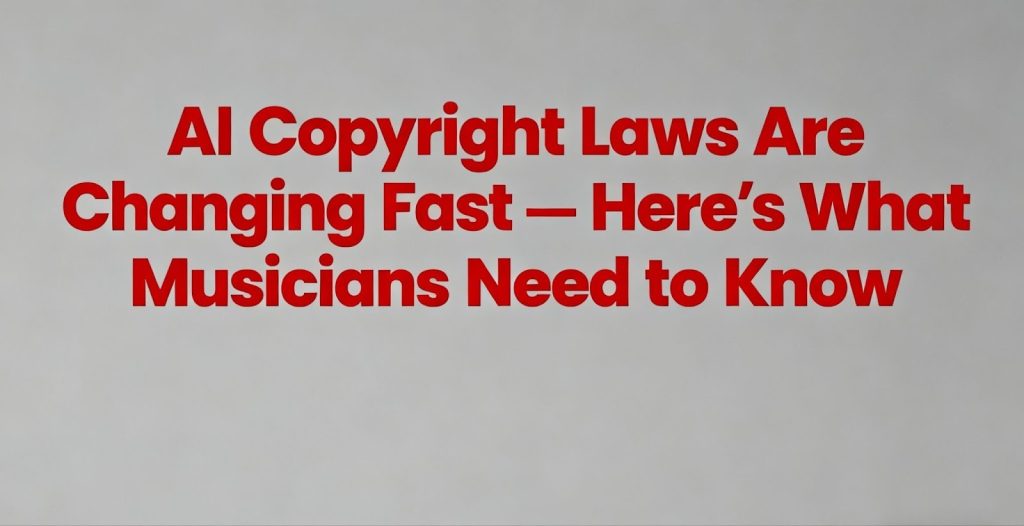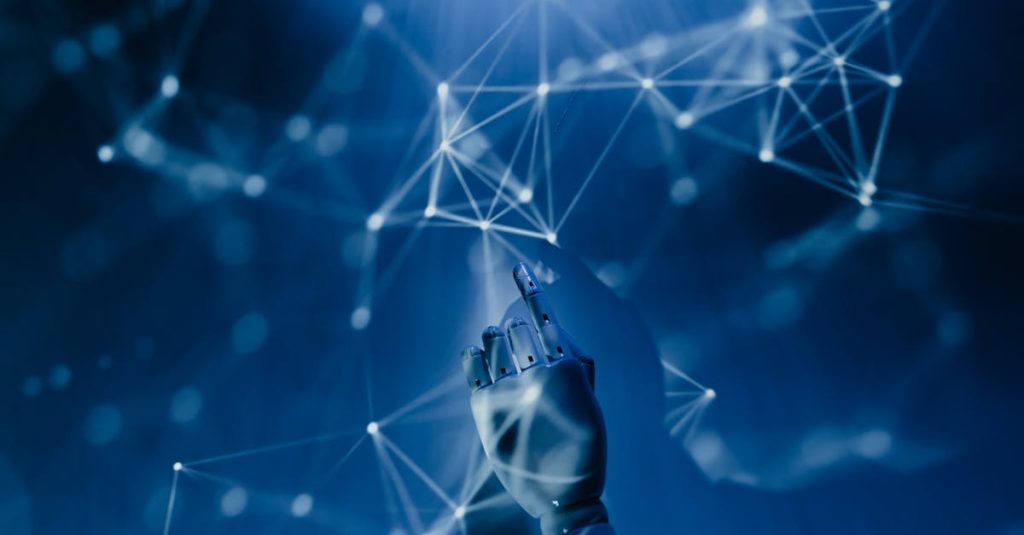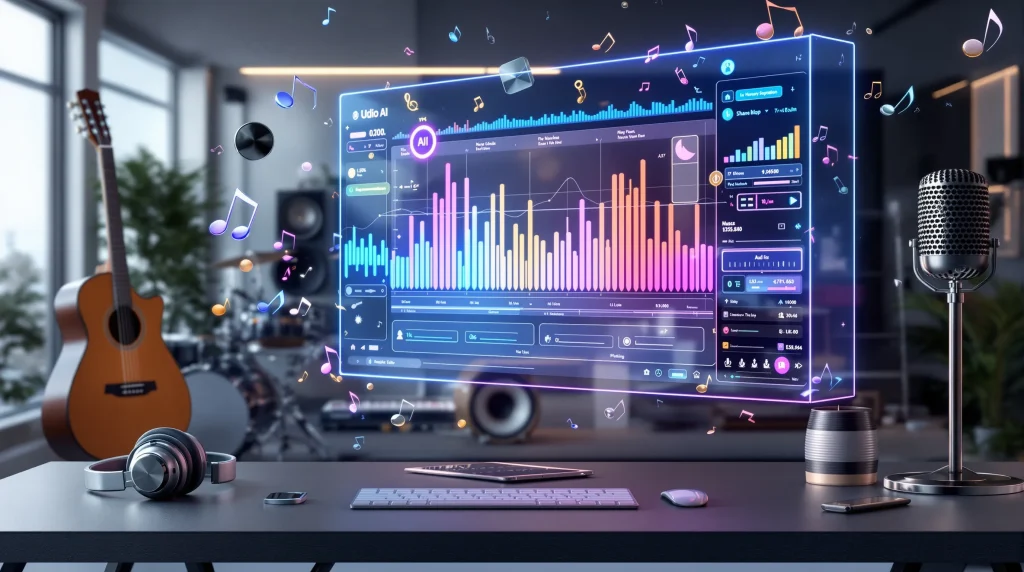2025年1月、米国著作権局は、純粋にAIが生成した楽曲は著作権で保護されないと宣言し、生成モデルを使用するクリエイターの状況を再定義した。音楽家は今、AIが支援する作品の法的保護と商業ライセンスを確保するために、人間の著作者であることを証明するという課題に直面している。本書は、オリジナリティの基本原則、政府ガイドライン、世界的な管轄区域の違い、実践的なコンプライアンスのヒント、そして新たな法規制を網羅し、AI音楽法のアップデートの要点を解き明かす。本書では、「十分な人間の入力」基準を満たす方法、ライセンスされていないトレーニングデータによる侵害リスクを回避する方法、ロイヤリティの枠組みをナビゲートする方法、および以下のようなプラットフォームを活用する方法を探求しています。 ムレカ シームレスな完全商用ライセンスとロイヤリティ・フリーの配布が可能です。ジェネレーティブAIでメロディーを作曲するにも、インストゥルメンタルをアレンジするにも ムレカの編集者, これらの洞察は、クリエイティブなアウトプットを保護し、国境を越えて効果的にマネタイズし、明日の音楽業界を形成する政策提言に参加する力を与えてくれる。.
AI音楽著作権と人間の著作権の基本とは?
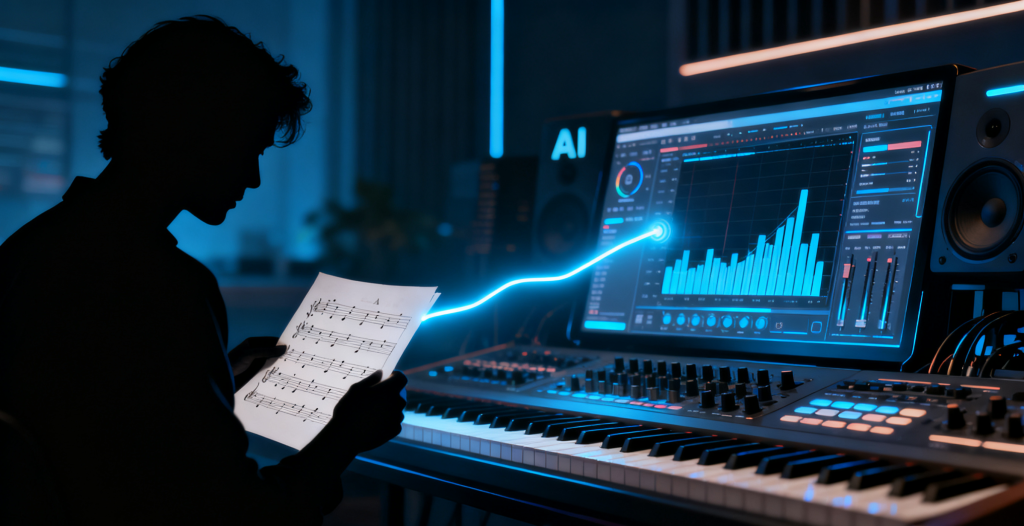
AIによって生成された音楽とは、既存のオーディオや楽譜を処理して新しい素材を生成する機械学習モデルによって作成または支援された楽曲を指す。これらのシステムは、著作権で保護された録音やパブリックドメインの録音の大規模なライブラリを使って学習するため、オリジナリティや所有権について疑問が生じる。著作権法は、メロディ、ハーモニー、歌詞、編曲において人間の創造性が確認できる場合にのみ、オリジナル作品を保護する。人間の創作性を主張することで、音楽家はAIがアシストした楽曲を複製、配布、ライセンスする排他的権利を確保する。この法的枠組みを理解することで、AIを組み込んだ楽曲を登録するための基礎が確立され、アーティストが意図的な創造的選択を統合しなければならない理由が明確になる。これらの基本を把握することで、法的要件を満たす戦略への扉が開かれ、人間の入力の定義、著作物の登録、侵害の回避に関する議論が整う。.
AIが生み出す音楽とは何か?
AIが生成する音楽は、ニューラルネットワークとパターン認識アルゴリズムを組み合わせて、楽曲、インストゥルメンタル、ボイスサンプルの膨大なデータセットを分析し、新しい出力を生成する。生成的敵対的ネットワークやトランスフォーマーなどのモデルは、オリジナルのシーケンスを生成する前に、メロディーのモチーフ、和声進行、リズムパターンを学習する。このアプローチは、最初の作曲を加速させ、技術者でないクリエイターが新しい音の領域を探求する力を与える。例えば、「イ短調のアップビート・ギター・リフ」のようなテキスト・プロンプトは、数秒のうちに複数のユニークなステムを生み出すことができる。. 自分の音楽を作り始めよう. .このプロセスを認識することで、創造的な可能性とデータの出所に関する法的課題の両方が明らかになり、音楽家が芸術的な方向性を文書化し、AI出力を改良して著作権を主張できるように導く。.
なぜ著作権保護には人間のオーサーシップが不可欠なのか?
法律や判例法は、著作権で保護される著作物を、人間の創造性の証拠を伴うものと定義しているからです。裁判所と米国著作権局は、メロディ作成、作詞作曲、ヴォーカル演奏、ミキシングにおいて人が行った決定の具体的な記録を要求している。こうした文書化された貢献がなければ、AIのアウトプットは著作権のないオートメーションとみなされる。オリジナルのフックを組み込み、歌詞を作り、アレンジを形作るミュージシャンは、AIが生成したトラックに彼らの創造的アイデンティティを刻み込む。この本質的な原則は、ジェネレーティブAIの急速な進歩の中で、音楽法が人間の表現を保護し続けることを保証する。.
AI音楽著作権を管理する法的機関は?
政府機関や国際機関は、AI音楽の著作権基準を設定し、施行している。米国では、米国著作権局がAI支援作品の独創性と登録基準に関するガイダンスを発行しています。欧州では、欧州連合知的所有権庁がEU著作権指令の人的著作者要件を解釈しています。英国では、英国知的所有権庁が著作権・意匠・特許法に基づく案件を審査しています。世界的には、世界知的所有権機関が、ジェネレーティブAIに対応するための政策の調和に関する対話を促進している。音楽家は作品を登録する際に関連当局に相談しなければならないが、これは各主体がオリジナリティの閾値、ライセンス義務、エンフォースメント・メカニズムについて微妙に異なる規則を適用しているためである。.
著作権法はAI支援音楽におけるオリジナリティをどう定義するか?
AIが支援する音楽における独創性は、アルゴリズムによるランダムな出力ではなく、個人的な表現を反映した創造的な選択にかかっている。法的なテストでは、人間の作者が最終的な作曲に意味のある構造や美的な方向性を課したかどうかが評価される。要素としては、プロンプトの複雑さ、編集の程度、ライブ演奏の統合、人間が作曲したセクションのレイヤーなどがある。裁判所は、独創的なアレンジ、メロディーのバリエーション、叙情的な中身の証拠を探します。このような属性を示すことで、音楽家はアルゴリズムによるスケッチを保護可能な作品に変え、人間の創意工夫とAIの生成能力との間に直接的なつながりを確立することができる。.
AIが支援する音楽を音楽家が著作権で保護するには?
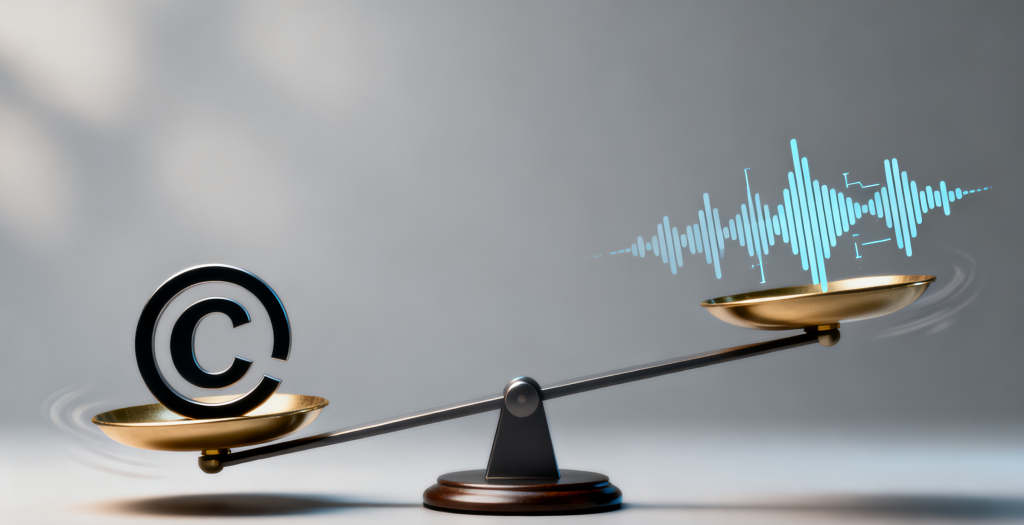
はい、音楽家は、法的基準を満たすのに十分な人間の入力を供給する場合、AI支援楽曲を著作権登録することができます。米国著作権局の2025年1月のガイダンスと2025年3月21日の控訴審判決によれば、ジェネレーティブAIと実証可能な人間の指示を組み合わせた作品は登録の資格がある。アーティストは、独創性の要件を満たすために、各創作段階(即興エンジニアリング、編集、演奏、編曲の決定)を文書化しなければならない。このプロセスは、独占権を可能にするだけでなく、潜在的な紛争における立場を強化する。これらのガイドラインを理解することで、音楽家は登録手続きをナビゲートし、AIによって強化された創作物を保護し、著作者人格権に関する政策の明確化に備えることができる。.
著作権における「十分な人的インプット」とは何か?
十分な人的投入を定義するには、3つの中核的な活動が必要である:
- 詳細なプロンプトとメロディーを作成し、芸術的な意図を通じてAIの出力を形成します。例えば AIメロディ・ジェネレーター.
- 生成されたステムの編集とアレンジ、ハーモニーやリズムの追加や修正。.
- 生のボーカルや楽器のパートなど、オリジナルのパフォーマンスをAIコンポジションに組み込む。.
これらの行為は、人間の介入を示す具体的な証拠となる。これがなければ、AI音楽は著作権保護されないままだ。プロジェクトファイル、バージョン履歴、セッションノートを記録することで、ミュージシャンは貢献の証拠をまとめ、登録申請を強化することができる。.
最近の米国著作権局ガイドラインはミュージシャンにどう影響するか?
米国著作権局の2025年1月の更新は、AI支援音楽は、人間の作者が主要な創造的要素に貢献した場合にのみ登録できることを明確にした。純粋にアルゴリズムによるアウトプットは除外される。このガイダンスは、迅速なトランスクリプト、プロジェクトの修正、人間による決定の記述といった文書化基準を概説することで、審査手続きを合理化するものである。2025年3月21日の控訴審判決は、意味のある人間の関与なしに生成された作品の保護を否定することで、この姿勢を強化している。音楽家は現在、著作者であることを証明するための明確な基準を持ち、著作権登録のために楽曲を提出する際の不確実性を減らしています。.
AI音楽著作権:AIが生成した作品に対する米国著作権局のスタンス
米国著作権局は現在、AIが作成した作品は著作権の対象にならないと規定している。AIソフトウェアが、憲法で規定されたAI以前の著作者概念とどのように関連するのかについて最新の理解がなければ、AIが生成した音楽に関連するいかなる主体(それが開発者であれ、ユーザーであれ、システムそのものであれ)に対しても、既存の人間のアーティストに対する侵害の責任を問うことはできない。したがって、本稿では、AIが生成した音楽から生じる著作権侵害と、人間が作った音楽から生じる著作権侵害との間に、重大な違いがあるのかどうかを明らかにしたい。執筆者
AIが生成した音楽の著作権におけるオーサーシップの定義
著作権のあるAI音楽とないAI音楽の実例とは?
プラットフォームツールを検討する前に、著作権の状態を説明する以下のシナリオを検討してください:
| シナリオ | ヒューマン・インプット | 著作権の状況 |
|---|---|---|
| 編集なしで短いプロンプトを使う | 基本テキストプロンプト “アンビエント・ピアノ曲” | 著作権の対象外 |
| AIステムの編集とコードの追加 | AIのメロディーをリアレンジし、ベースを加え、テンポを調整した。 | 著作権保護対象 |
| AIのバッキングに生のボーカルを重ねる | AIインストゥルメンタルのオリジナル・ボーカル・レコーディング | 著作権保護対象 |
| AIの出力をそのまま受け入れる | 世代以降は修正なし | 著作権の対象外 |
これらの事例は、意図的な編集やオリジナル要素の統合が、オリジナリティ・テストを満たし、登録をサポートすることを示している。この違いを認識することは、アーティストが権利を確保するための制作ワークフローを計画するのに役立つ。.
Murekaはどのように人間のクリエイティブ・コントロールと著作権コンプライアンスをサポートしていますか?
ムレカ と人間の芸術性を融合させるための総合的な環境を提供する。 高度AI世代. .V7.5モデルは、プロ級のインストゥルメンタル、ボーカル、アレンジを5分以内に作成します。内蔵エディターでメロディー・モチーフやハーモニック・ストラクチャーの微調整ができ、内蔵のバージョン履歴であらゆるアーティスティックな選択が記録されます。Murekaで生成されたすべてのトラックには以下が付属しています。 完全な商業ライセンス権 とロイヤリティ・フリーの保証により、非ライセンスのトレーニング・データに対する懸念を払拭します。透明性の高いメタデータとエクスポート・ログにより、ミュージシャンに力を与えます、, ムレカ は、国内外の登録要件を簡単に満たすことができる。.
AI音楽の法的リスクと著作権侵害問題とは?
AI音楽は、モデルがライセンスや著作権のないデータセットで学習する場合、固有の法的リスクを伴う。保護されたレコーディングから同意なしにデータをスクレイピングすると、結果のアウトプットを使用するクリエイターに対して権利侵害のクレームが発生する可能性がある。これらのリスクを理解することは、音楽家が責任ある慣行を採用し、適切なクリアランスを確保し、潜在的な訴訟から身を守るのに役立ちます。トレーニングデータの出所、フェアユースの解釈、進行中の法廷闘争に関連する課題を予測することで、アーティストは法的な混乱なしに責任を軽減し、創作の勢いを維持することができます。.
AIモデルはどのように学習され、なぜ学習データが重要なのか?
ジェネレーティブAIモデルは、膨大な量のオーディオや楽譜を取り込むことでパターンを学習する。トレーニングデータセットに著作権で保護された素材が無断で含まれている場合、派生的な出力は第三者の権利を侵害する危険性がある。AIのサンプルが斬新に見えても、その根底にある要素は保護された著作物を反映している可能性がある。音楽家は、AIサービスが倫理的にデータを調達しているかどうかを確認し、トレーニング資料の条件を確認する必要がある。データセットの出所に関する透明性を確保することで、侵害の申し立てにさらされる機会を減らし、クリエイティビティを法的なベストプラクティスに合わせることができる。.
AI音楽著作権侵害:AI学習データにおけるリスク
著作権侵害のリスクは、既存の音楽をAIに学習させる場合に顕著に現れる。学習プロセスにはコピーやデータの複製が含まれるため、適切に処理されなければ著作権の問題につながりかねない。したがって、AIのトレーニングに適用できる著作権の枠組みは、こうした懸念に対処するために極めて重要である。.
AIが創造した音楽-著作権侵害か、新たな創造か、2025年
AI音楽のトレーニングと使用におけるフェアユースの役割とは?
フェアユースは、目的、性質、量、市場効果などの基準の下で、許可なく著作物を限定的に使用することを認めるものである。AIトレーニングにおいては、研究や非商業的な実験はフェアユースとして適格かもしれないが、商業的な展開はしばしばこれらの保護から外れる。裁判所は、AIモデルのトレーニングがオリジナルのコンテンツを著しく変容させるかどうか、そしてライセンス市場が害されるかどうかを評価する。音楽家は、AIツールキットのフェアユース例外の範囲を評価し、変形的利用を文書化し、創作から商業化に移行する際にライセンシングを検討しなければならない。.
AI音楽プラットフォームをめぐる現在の訴訟と法廷闘争とは?
大手レーベル(ソニー・ミュージック、ワーナー・ミュージック、ユニバーサル・ミュージック・グループ)は、スノウやアムネスティのようなAIプラットフォームに対して訴訟を起こしている。 ウディオ, トレーニングデータにおける著作権保護された音源の無許諾使用を主張している。2023年から2024年にかけて、このような注目度の高い事件が発生し、データセットのコンプライアンスがいかに重要であるかが浮き彫りになった。一部のAI新興企業は、訴訟を回避するために音楽出版社とライセンス契約を交渉している。現在進行中の訴訟は、プラットフォームの透明性の重要性を強調し、AIを使用するミュージシャンは、法的な影響から身を守るために著作権法を尊重するサービスを選択しなければならないことを補強している。.
音楽家は著作権侵害のクレームからどのように身を守ることができるか?
ミュージシャンはいくつかの手段でリスクを減らすことができる:
- 選択したAIツールがライセンスまたはパブリックドメインのデータセットを使用していることを確認する。.
- プロンプト、編集、人的貢献の詳細な記録を維持する。.
- サードパーティのサンプルやループのライセンスを確保する。.
- AIプラットフォームの条件を受け入れる際には、免責条項や責任条項を検討する。.
これらのステップを実行することで、侵害主張に対する強固な防御が構築され、合法的な創造的実践に対するアーティストのコミットメントが強化される。.
音楽家にとってAI音楽ライセンスとロイヤリティはどのように機能するのか?
AIが生成する音楽のライセンスモデルは、その範囲、コスト、付与される権利において様々である。ロイヤリティ・フリーのライセンスは、継続的な支払いなしに広範な利用を認めるが、商業ライセンスは利用制限や収益分配を課す場合がある。これらの枠組みを理解することで、ミュージシャンはシンク・プレイスメント、ストリーミング、またはマーケットプレイスでの販売を通じて、AIが支援する作品を収益化することができる。配信前にライセンス条件を明確にすることで、アーティストの収益を保護し、プラットフォームのポリシーに確実に準拠することができる。.
AIが生み出す音楽のさまざまなライセンスモデルとは?
AI音楽は通常、3つのライセンスの枠組みで提供されている:
- ロイヤリティフリーライセンスは、追加料金なしで無制限の商用利用を許可します。.
- 商用ライセンスは、特定のプロジェクトやメディア形式での使用権を付与するものです。.
- 伝統的な出版契約は、コレクティング・ソサエティが管理する演奏使用料を伴う。.
どのモデルも、柔軟性、コスト、権利管理のバランスが取れているので、アーティストは配信の目標に沿った選択肢を選ぶべきだ。.
ミュージシャンはAIが支援する音楽をどのように合法的に収益化できるか?
ミュージシャンは、AIが支援する創作物を収益化することができる:
- 配給 ロイヤリティ・フリー・トラック ストリーミング・プラットフォームで。.
- ビデオ、ゲーム、広告用のカスタムAIコンポジションを提供。.
- AIアシスト作品を受け入れている図書館を通じてライセンスを同期させる。.
- 統合されたマーケットプレイスでステムまたはフルマスターを販売する。.
ライセンシング戦略をターゲット市場に適合させることで、アーティストは法的透明性を維持しながら収益源を生み出す。.
ムレカのロイヤリティフリーおよび商業ライセンスに対するアプローチとは?
Murekaは、生成されたすべてのトラックに対して完全な商業ライセンス権を発行し、ミュージシャンがロイヤリティの義務を負うことなく、AIが作成した音楽を配布、同期、販売できることを保証します。Murekaに組み込まれたメタデータとエクスポートログは、各楽曲のオーサーシップとライセンシングステータスを文書化します。このアプローチは、クライアントの権利クリアランスを簡素化し、クリエイターが契約交渉よりも芸術性に集中できるようにします。.
AI音楽の新しいロイヤリティ・モデルはどのように生まれているのか?
業界では、使用ごとに少額の料金を請求するダイナミック・マイクロ・ライセンス、透明性の高い支払いを実現するブロックチェーン対応のロイヤリティ・トラッキング、無制限のAI作曲クレジットを付与するサブスクリプション・サービスなどが試みられている。これらのモデルは、報酬と消費を一致させ、ミュージシャンに柔軟な収入の選択肢を与えると同時に、権利者への公正な報酬の還流を保証することを目的としている。.
AI音楽著作権法は国際的にどう違うのか?
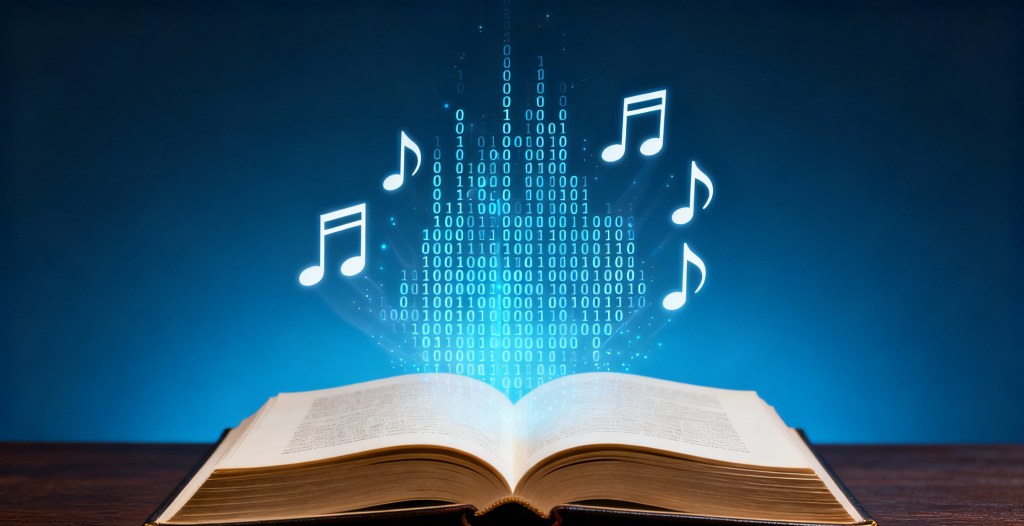
AI音楽の著作権の枠組みは、著作者と独創性の定義が法律で定められているため、法域によって異なっている。米国は人間の創造的な選択を重視しているが、欧州連合(EU)はInfoSoc指令の下で独創的な知的努力を要求しており、英国は「技能と判断」基準を適用している。これらの違いを認識することは、音楽家がAI支援作品を世界的にリリースする際に、保護を確保し、ライセンシング戦略を適応させるのに役立つ。.
米国、EU、英国のAI音楽著作権法の主な違いは?
国境を越えたリリースを検討する前に、この比較について考えてみよう:
| 地域 | ヒューマン・インプットの要件 | 要登録 | 執行機関 |
|---|---|---|---|
| 米国 | “「十分な」創造的貢献 | はい、著作権局を通じて | 米国著作権局、連邦裁判所 |
| 欧州連合 | “独自の知的努力” | 加盟国によって異なる | EUIPO、各国知財庁 |
| イギリス | “技術と判断力” | 推奨されるが必須ではない | UKIPO、英国の裁判所 |
グローバルなハーモナイゼーションの努力はAI音楽法をどのように形成しているか?
世界知的所有権機関(WIPO)は加盟国を招集し、ジェネレーティブAIと著作権のベストプラクティスを議論している。提案されている条約は、AIトレーニングにおける透明性のための統一要件を確立し、国境を越えた登録を認めることを目指している。これらの取り組みが進めば、音楽家はAI支援作品を国際的に保護・ライセンスするための明確な道筋から恩恵を受けることになる。.
国境を越えたAI音楽のライセンスについて、ミュージシャンは何を知るべきか?
AIが支援する音楽を海外で配信する場合、アーティストは次のようにすべきです:
- ライセンスが派遣先の管轄区域の要件に準拠していることを確認する。.
- レジスターは主要な市場で執行を強化する。.
- 各地域の実演権団体が管理する地域的な使用料徴収規則を考慮する。.
- メタデータと文書を各地域の登録フォーマットに合わせる。.
この積極的なアプローチにより、法的な明確性を確保し、グローバルなプラットフォームにおける収益の可能性を最大化します。.
AI音楽著作権と音楽家の権利の今後の展望は?
新たな法律や政策提案は、クリエイティブ産業におけるAIの役割をさらに明確にすることを約束している。議員たちは、AIのトレーニングソースの透明性を義務付ける「Generative AI Copyright Disclosure Act(AI著作権開示法)」のような法律を策定している。同時に、アーティストやアライアンスは、オリジナル・クリエイターを尊重し、データ貢献者に報酬を与えるオプトイン・ライセンス・モデルを求めてロビー活動を行っている。常に情報を入手し、アドボカシー活動に参加することで、ミュージシャンはイノベーションと保護のバランスをとる公正なルールの形成に貢献することができる。.
どのような法改正や政策変更が控えているのか?
現在検討されている主な取り組みは以下の通り:
- ジェネレーティブAI著作権開示法、AIシステムに使用した著作権のあるソースの記載を義務付ける。.
- EUのAI法改正、モデルトレーニングに作品を提供するアーティストの権利を導入。.
- マルチメディアAIコンポジションに関する米国登録ガイドラインの更新案。.
これらの措置は、ジェネレーティブAI開発における説明責任を成文化し、人間の創造性と法的認知の結びつきを強化することを目的としている。.
アーティストや業界のリーダーたちは、公正なAI音楽法をどのように提唱しているのか?
サー・ポール・マッカートニーやサー・エルトン・ジョンのような著名な音楽家たちは、AIトレーニングを支える原作者たちに補償を与える、透明性のあるオプトイン・ライセンスの枠組みを求めている。業界団体は、AI開発者と集団的ライセンス契約を交渉するために連合を形成している。この統一戦線は、音楽家が政策改革を推進し、AI時代により公正な収益分配を確保できることを示唆している。.
AIが生成する音楽における人間の創造性の保護:ライセンスの枠組み
音楽、テキスト、画像、動画など、人間が作成したコンテンツは、ジェネレーティブAIシステムのバックボーンを形成する。しかし、結果としてAIが生成した作品は、オリジナルの創作物と直接競合する。このダイナミズムは、クリエイティブ産業、特に音楽分野に新たな機会と課題の両方をもたらす。ジェネレーティブAIの公正で倫理的かつ持続可能な市場は、人間のクリエイターを支援し、その知的財産権を効果的に保護する強力な法的枠組みにかかっている。AIサービス・プロバイダーと音楽クリエイターの利害を一致させるためには、公平なアクセスとオリジナル・クリエイターの保護の両方を保証する、新たなライセンシングの枠組みが不可欠である。.
効果的なライセンシングを通じてAIが生成する音楽における人間の創造性を保護する, S Jacques, 2024
音楽家は進化するAI音楽法的状況にどう備えるか?
ミュージシャンは、次のような方法で練習の将来性を高めることができる:
- アップデートの購読 米国著作権局とWIPOから。.
- AIにおけるアーティストの権利を擁護する専門団体に参加する。.
- クリエイティブなプロセスを正確なログとメタデータで記録。.
- ライセンスされたデータセットを優先し、明確な商業的権利を提供するAIプラットフォームを選択する。.
積極的な関与は、アーティストが法的発展の最前線に立ち続け、作品をコントロールし続けることを保証する。.
AIが生み出す音楽の権利を守るために、音楽家はどのような実践的手段を取ることができるのか?
AIが支援する楽曲の保護は、体系的な文書化、慎重な契約審査、賢いツールの選択から始まる。最初のプロンプト作成から最終的なマスタリングまで、すべての段階にベストプラクティスを組み込むことで、ミュージシャンは著作者としての主張を強化し、強固な法的地位を確保することができる。以下のセクションでは、アーティストがすぐに実行できる対策を詳しく説明する。.
AIツールを使用する際、人間のクリエイティブ・インプットをどのように文書化するか?
音楽家は、タイムスタンプを押した記録を保持すべきである:
- 芸術的な意図を反映したトランスクリプトを促す。.
- 段階的な編集を示すバージョン管理されたプロジェクトファイル。.
- アレンジの選択と演奏の録音についてのセッションノート。.
これらの記録は、人間の積極的な指示を証明する監査証跡を形成し、登録時のオリジナリティの主張をサポートする。.
AI音楽プラットフォームの規約とライセンス契約をどうナビゲートするか?
アーティストはプラットフォームの利用規約をよく読み、以下の点に注意しなければならない:
- 許諾された権利の範囲(商用、同期、二次的利用)。.
- ライセンス料のスケジュールと収益分配条項。.
- 侵害責任を割り当てる補償条項。.
- データ所有ポリシーとトレーニングデータセットの開示。.
これらの条件を理解することで、不測の事態を防ぎ、サービス・プロバイダーではなくクリエイターに権利が残るようにする。.
Murekaのツールを使って著作権保護を最大化するには?
Murekaのエディターは、メロディーの微調整から最終的なミキシング調整まで、各修正をキャプチャし、タイムスタンプを付けます。マスターと一緒にメタデータをエクスポートすることで、ミュージシャンは人間の決断の包括的な記録を得ることができます。すべての楽曲には完全な商業ライセンス権が付随し、統合されたマーケットプレイスでは、文書化されたオーサーシップを持つトラックの透明性のある取引が可能です。この技術的機能と法的保証の組み合わせは、現在の著作権基準の下で、AI支援作品を保護します。. プライバシーポリシー をご覧ください。.
AI音楽著作権に関する信頼できる法的資料と最新情報はどこで見つかるか?
権威あるガイダンスについては、アーティストが参考にできる:
- 人工知能と創作物に関する米国著作権局の出版物。.
- AIと知的財産に関する世界知的所有権機関の政策概要。.
- エンターテイメント専門の法律事務所による業界ブログ。.
- AI訴訟やライセンシングの動向をカバーする音楽ビジネス専門誌。.
これらの情報源を定期的に見直すことで、ミュージシャンは、政策の変更、新たなベストプラクティス、および世界的な法的解釈に関する情報を得ることができます。.
音楽家は、人間のオーサーシップを優先し、細心のドキュメントを維持し、透明なライセンシングを保証するプラットフォームを選択することで、急速に変化するAI音楽著作権の状況をナビゲートすることができます。グローバルな政策議論に積極的に関与し、以下のようなツールを活用する。 ムレカ 完全な商業的権利のために、創造的な努力は保護され、利益を生む。法律が進化していく中、常に情報を入手し、業界標準に合わせることで、アーティストはAIによる音楽の未来を形成し、作品に対する永続的なコントロールを確保することができる。.

